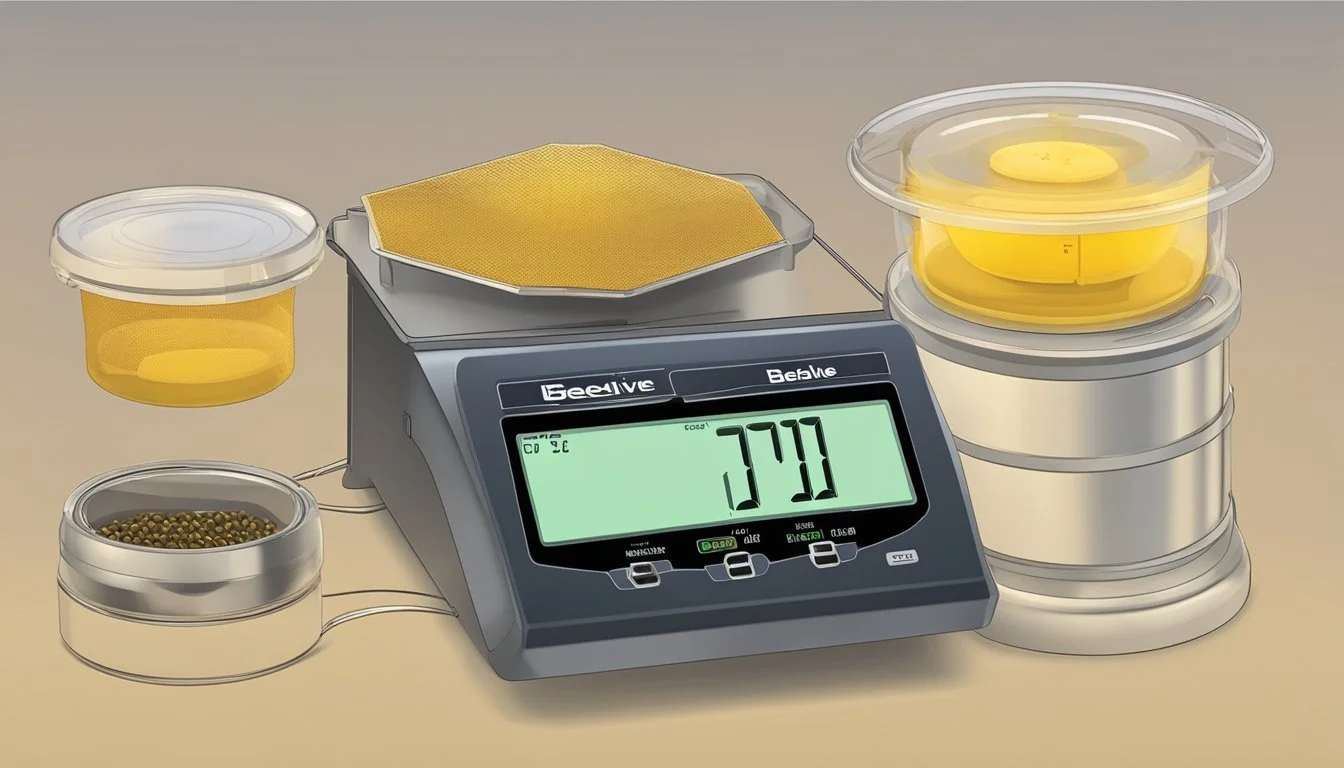The Ultimate Guide to Using a Digital Beehive Scale
Boost Your Homestead Honey Production Monitoring
Beekeeping is a fine art that combines tradition with technology, and having a digital beehive scale is an advanced practice for beekeepers who aim to monitor honey production with precision. Digital beehive scales offer a non-intrusive way to track the changes in hive weight, which is directly correlated to honey production. They provide vital data points, allowing beekeepers to understand trends and make informed decisions regarding the health and productivity of their hives.
A digital beehive scale's utility goes beyond mere weight measurement. By offering insights into the daily weight fluctuations of a hive, beekeepers can deduce bee activity, swarming events, and nectar flow in real-time. This technology is integral for those seeking to optimize honey yields, as it allows for immediate adjustments in beekeeping practices based on quantitative data.
The implementation of such a tool on a homestead can lead to effective apiary management strategies, enabling beekeepers to track seasonal patterns of honey accumulation and plan their harvests accordingly. As environmental conditions have a significant impact on honey production, digital beehive scales can also assist in evaluating how weather patterns affect the hive, ensuring that beekeepers can protect and provide for their colonies in the face of changing climates.
Understanding Beehive Scales
The precision of digital beehive scales is essential for homesteaders seeking to monitor honey production efficiently. These scales provide vital data that can influence decision-making in hive management.
What Is a Digital Beehive Scale?
A digital beehive scale is a device designed to measure the weight of a beehive with high accuracy. It's typically equipped with sensors that transmit weight data to a digital display or a connected device. Its primary function is to provide beekeepers with real-time feedback on the weight changes in their hives, which is an indicator of honey production and overall hive health.
The Importance of Accurate Weight Measurement
Accurate weight measurement is crucial in beekeeping for several reasons. Firstly, it allows beekeepers to track honey production without disturbing the bees by opening the hive. This is key to minimizing stress on the colony. Additionally, a precise weight reading can alert beekeepers to changes within the hive, such as swarming, nectar flow, and potential issues with the queen.
Key aspects of weight accuracy include:
Consistency: Reliable data over time helps beekeepers identify trends.
Calibration: Ensures the readings are accurate to a known standard.
How Beehive Scales Enhance Hive Management
Beehive scales enhance hive management by providing valuable insights that can inform a range of beekeeping decisions. For example, weight data can assist in determining the best time for honey harvesting or feeding the bees supplemental food. It can also be a marker for the colony's health, as sudden weight loss might indicate pest infestation or disease.
Monitoring Growth: Tracking weight gain during the nectar flow season.
Winter Preparation: Ensuring the hive has enough weight (stored honey) to survive.
By utilizing a digital beehive scale, beekeepers can make informed decisions based on quantitative metrics, leading to improved productivity and healthier hives.
Monitoring with Digital Beehive Scales
Digital beehive scales are essential for modern beekeepers, allowing continuous assessment of hive health and productivity by tracking weight and temperature changes over time.
Continuous Monitoring for Informed Decisions
The use of digital beehive scales provides beekeepers with continuous monitoring capabilities. They can record the hive weight at regular frequency, optimizing for hive health and honey production. By keeping a constant eye on the weight, beekeepers can make informed decisions regarding harvesting times and understand the overall well-being of the bee colony.
Real-Time Data and Critical Notifications
Real-time data is a significant advantage of digital beehive scales. Beekeepers receive updates that reflect the immediate condition of their hives. These systems can also send critical notifications related to sudden weight changes, which could indicate swarming, honey theft, or potential hive collapse—key information for immediate action.
Interpreting Weight and Temperature Data
Successful beekeeping requires understanding the correlation between hive weight, honey production, and hive temperature. Digital scales can detect minute weight changes to infer nectar flow and bee activity. Moreover, temperature data helps beekeepers monitor brood health, as bees maintain specific conditions for brood rearing. Sudden temperature shifts can signal potential issues requiring attention.
Technological Aspects of Beehive Scales
Digital beehive scales revolutionize honey production monitoring with advanced hardware and software integration, enabling remote beehive monitoring. These scales provide beekeepers with precise data that assist in effective hive management.
Understanding the Hardware Components
The hardware of digital beehive scales typically includes load cells, which measure the weight, and an assortment of environmental sensors. These sensors can detect temperature, humidity, and more, which are critical for understanding the conditions inside the hive. The hardware is designed to endure outdoor conditions while providing accurate readings.
Exploring Software and Web App Integration
Digital beehive scales are often paired with specialized software or web apps that collect data from the hardware. Beekeepers can view detailed reports and trend data which are crucial for decision-making processes. These platforms allow for the tracking of weight gains in the hive, which can be indicative of honey production levels.
Features of software integration:
Real-time data access
Historical data analysis
Notification alerts for significant changes
Remote Beehive Monitoring via Wireless Technologies
Utilizing wireless technologies, beekeepers have the ability to perform remote beehive monitoring. This reduces the need for frequent manual inspections that can disturb the bees. Smart sensor systems send data to a central hub which then transmits it to the beekeeper's device, ensuring they are informed about the status of their hives from anywhere.
Wireless technologies in use:
Wi-Fi
Bluetooth
Cellular networks
Smart sensor systems are at the heart of these wireless solutions, providing the means to collect and transmit valuable hive data remotely.
Factors Affecting Honey Production
Honey production hinges on several pivotal aspects, ranging from environmental conditions to the vitality of the hive. Understanding these elements is crucial for homesteaders to effectively manage and improve honey yields.
Examining Environmental Influences
Environmental factors substantially dictate the amount of honey bees can produce. Weather conditions like temperature and humidity can either enhance or impede bee activity. Bees prefer moderate conditions for foraging; extreme heat or cold can reduce their efficiency. Rainfall patterns influence nectar flow, a vital source of food for bees necessary for honey production. Prolonged dry spells or excessive rain can disrupt the availability of nectar, adversely affecting honey yield.
Nectar Flow and Bee Activity Monitoring
Nectar availability is a direct precursor to honey production. Homesteaders should monitor the nectar flow using a digital beehive scale to track the weight change of the hive, which indicates nectar being brought in and converted to honey. By correlating weight data with local flowering patterns, they can predict peak production times. Bee activity also aligns closely with nectar flow; more active foraging leads to increased honey.
The Effect of Hive Conditions on Bee Health
Healthy bees are the cornerstone of high honey production. Hive health involves maintaining proper ventilation to prevent moisture build-up, which could lead to mold and diseases. Monitoring humidity levels inside the beehive can mitigate these risks. Conversely, poor beehive conditions can contribute to colony collapse disorder, a significant threat to bee populations. Homesteaders should ensure hives are free of pests and diseases to support a robust bee community, culminating in better honey yields.
Optimization and Productivity
Digital beehive scales are a powerful tool for homesteaders looking to enhance honey production. By leveraging precise data, beekeepers can maximize production, streamline management, and accurately predict peak nectar flows.
Maximizing Honey Yield Through Data Insights
Real-time Monitoring: Digital scales provide real-time data on hive weight, crucial for understanding honey accumulation.
Immediate insights allow for strategic decisions to optimize honey yield.
Weight fluctuations indicate honey flow trends and bee activity.
Data Analysis: Historical data analysis can lead to identifying patterns in honey production.
Comparing weight data with local flowering cycles pinpoints major nectar flow.
Insights help target the best times for honey harvesting to maximize yield.
Efficiency in Beehive Management and Harvesting
Streamlined Processes: Digital beehive scales enhance efficiency by monitoring several parameters that impact productivity.
Weight data can guide optimal times for hive inspections and maintenance.
Labor and time are saved through reduced need for manual inspections.
Harvest Timing: Knowing the exact weight allows beekeepers to time the harvest precisely, leading to increased productivity.
Scales indicate when supers are full and ready for extraction.
Harvesting can be aligned with peak honey weight, ensuring high-quality produce.
Predicting Major Nectar Flows and Peak Periods
Environmental Impact Analysis: Digital scales can help correlate environmental factors with productivity.
Environmental sensors detect conditions affecting nectar availability.
Beekeepers can adapt hive management to anticipate and exploit peak blooming periods.
Predictive Insights: Advanced data analytics can forecast periods of high nectar flow, enabling proactive management.
Predicting these trends allows for preparation to yield more honey during peak times.
Understanding major nectar flows leads to strategic placement of hives in high forage areas.
Practical Considerations for Beehive Scales
When choosing a beehive scale for monitoring honey production, one must consider the logistics of installation, the cost against potential return on investment (ROI), and selecting the appropriate technology for their apiary's specific needs.
Installation and Maintenance of Scales
Proper installation is crucial for the accurate functioning of a digital beehive scale. The scale should be positioned so that it is level and securely supports the hive through its load cell mechanism. Users should verify that their chosen scale is accompanied by a straightforward installation manual. Regular maintenance, which includes checking for corrosion and ensuring the scale is clean, helps in prolonging the lifespan of the device. Also, the power supply—whether it's battery or solar—should be checked to prevent data loss.
Cost and ROI of Beehive Scale Investment
The price of a smart beehive scale can vary significantly, depending on the features and technology used, such as Arduino or Raspberry Pi systems. Hardware that allows for additional apiary insights may have a higher initial cost. However, the ROI should be evaluated based on the time saved in manual checks and the value of the accurate, real-time data provided. The increase in efficiency and potential increase in honey production can make the investment worthwhile.
Choosing the Right Scale for Your Apiary
Selection of the correct scale requires assessing the apiary size and the beekeeper's data needs. For example, a smart beehive scale that integrates seamlessly with other monitoring systems via an Arduino or Raspberry Pi may offer more data but will also require a beekeeper who is comfortable working with these technologies. It's important to consider the maximum weight limits of the scale, its connectivity options, and how the collected data will be accessed and utilized.
The hardware should be durable, capable of withstanding environmental factors specific to beekeeping, and should require minimal intervention to avoid disturbing the bees. When implemented effectively, the right beehive scale can lead to a more informed and productive apiary management strategy.
Advanced Features and Innovations
Digital beehive scales equipped with advanced features and innovations enhance the monitoring of honey production, leveraging cutting-edge technologies for accuracy and efficiency. The integration of computer vision, acoustic analysis, and IoT connectivity transforms the art of beekeeping into a data-driven science.
Computer Vision and Real-Time Imaging Systems
Computer vision-based approaches utilize high-resolution cameras to monitor hive activity and inspect honeycomb structure, enabling beekeepers to make informed decisions. Real-time imaging systems provide a continuous visual feed of the hive's interior, which is essential for the early detection of diseases, parasites, and other issues that could affect honey production.
Sound Measurement and Hive Acoustics Analysis
Sound measurement tools within the hive capture the acoustic footprint of the colony. Precision instruments process the audio to assess hive status, analyzing parameters like frequency and amplitude that could indicate changes in bee activity or health. Hive acoustics analysis helps beekeepers to detect abnormalities that might not be visible, such as a stressed colony or the presence of a new queen.
Leveraging IoT and Smart Beehive Scales
IoT connectivity turns smart beehive scales into a central piece of precision instruments that seamlessly integrate with other hive sensors. These smart scales track weight fluctuations in real-time, correlated with weather patterns, nectar flow, and honey production levels. Beekeepers can access this information from their devices, enabling timely and informed intervention strategies.
Troubleshooting and Alerts
When managing a beehive with a digital scale, a beekeeper may encounter various technical issues and receive alerts that require prompt attention. Troubleshooting these effectively ensures that honey production monitoring is accurate and continuous.
Dealing with Common Issues and Alerts
When common issues arise, the beekeeper should first check the connectivity and power supply of the hive sensor. Often, alerts can be triggered by simple disconnections or low battery power. It's also important to periodically inspect the sensor calibration to ensure the accuracy of weight measurements. If the issue is not resolved by these initial checks, consulting the manufacturer's manual or customer support can guide the beekeeper through more specific troubleshooting steps.
Alert Examples and Resolutions:
Low Battery Alert: Replace the batteries or charge the device if rechargeable.
Lost Connection Alert: Verify the range and obstacles between the sensor and the receiver, adjusting their positions as needed.
Understanding and Responding to Critical Alerts
Critical alerts involve scenarios that could significantly harm the colony or compromise the monitoring system. These include drastic weight changes, signaling possible theft or swarming, and extreme temperature fluctuations, which could indicate hive health issues. Upon receiving a critical alert, immediate investigation is crucial. For instance, a sudden weight drop could require a beekeeper to check the hive for signs of theft or examine the local environment for other influences on the colony's well-being.
Critical Alert Examples and Immediate Actions:
Rapid Weight Decrease: Inspect the hive for theft, swarming, or structural issues.
Temperature Alert: Assess the hive for potential overheating or cold exposure, and modify the hive environment accordingly.
Ensuring Continuity of Monitoring Systems
To maintain continuous monitoring, it is vital for the beekeeper to regularly update the firmware and software associated with the beehive monitoring system. This not only prevents technical glitches but also ensures that the latest features and improvements are in use. Moreover, establishing a routine schedule for maintenance checks can pre-emptively identify potential issues before they disrupt monitoring. Redundant systems or backup sensors can be employed to maintain continuity in case the primary monitoring tool fails.
Maintenance Checklist:
Firmware Updates: Apply updates as soon as they are available.
Regular Sensor Tests: Perform scheduled checks to confirm proper sensor functioning.
By following these guidelines, a beekeeper can adeptly manage alerts, troubleshoot issues, and ensure the digital beehive scale provides reliable monitoring for honey production on their homestead.
Integrations and Data Management
Managing data and integrating beehive scale systems with other apiary tools is crucial for maximizing honey production on a homestead. Efficient data management allows beekeepers to make informed decisions and maintain healthy colonies.
Incorporating Beehive Scales with Other Apiary Tools
Beehive scales are often part of a larger system of apiary management tools that can include sensors for temperature, humidity, and hive weight. Beekeepers can integrate these tools through specialized software platforms that aggregate data from various sensors into a single, cohesive dashboard. These platforms may support real-time monitoring and delivering actionable insights that are essential for the proactive management of beehives.
Data Export and Analysis for Beekeepers
Exporting data into commonly used formats such as csv, xls, or xlsx files is a standard feature of digital beehive scales. This functionality allows beekeepers to perform comprehensive data analysis using their preferred tools. Analyzing such data helps them to track trends related to honey production and hive health, ensuring that they can detect any abnormalities swiftly.
Data Usage Included: Honey production trends
Format Supported: csv, xls, xlsx
Data Usage Included: Hive weight variations
Format Supported: csv, xls, xlsx
Data Usage Included: Environmental conditions
Format Supported: csv, xls, xlsx
The Role of Mobile Data and Email Reporting
The utilization of mobile data has enabled beekeepers to receive updates regardless of their location. Beehive scale systems can be configured to send weekly reports via email, often summarizing the hive's performance and offering comparative analyses against historical data. Beekeepers can set thresholds that trigger instant alerts in case of significant changes, ensuring they can react promptly to any potential issues.
Practical Benefits of Using Beehive Scales
Beehive scales offer numerous practical benefits, from streamlining beekeeping practices to ensuring the health and productivity of honeybee colonies. These tools facilitate meticulous monitoring and management, which is essential for successful beekeeping.
Improving Workflow and Beehive Management
Beehive scales enable better workflow management by providing accurate data on hive weight, which directly correlates with honey production. A digital scale minimizes the disruption to the bees during inspection, allowing beekeepers to weigh hives quickly and efficiently. By incorporating these scales, beekeepers can optimize their workflow, eliminating unnecessary trips to the hives, and can make informed decisions based on real-time data.
Enhancing Honey Bee Colonies' Health Through Monitoring
The health of honey bee colonies can be indirectly monitored through weight. An unexpected drop in weight can signify issues such as a decrease in nectar flow or potential colony health problems. By using beehive scales, beekeepers can take preemptive measures to address any concerns, thus enhancing the overall health and viability of their colonies. These scales also aid in evaluating the strength of a colony throughout the seasons.
Economic Advantages and Time Management
Beehive scales can make a substantial economic impact by facilitating better time management and reducing labor costs. Beekeepers can strategically plan harvests and maximize honey yield by knowing the right time to extract honey based on hive weight, without the need for frequent manual checks. By determining the optimal time for resource allocation and honey extraction, beekeepers can see economic advantages in terms of both productivity and profitability.










